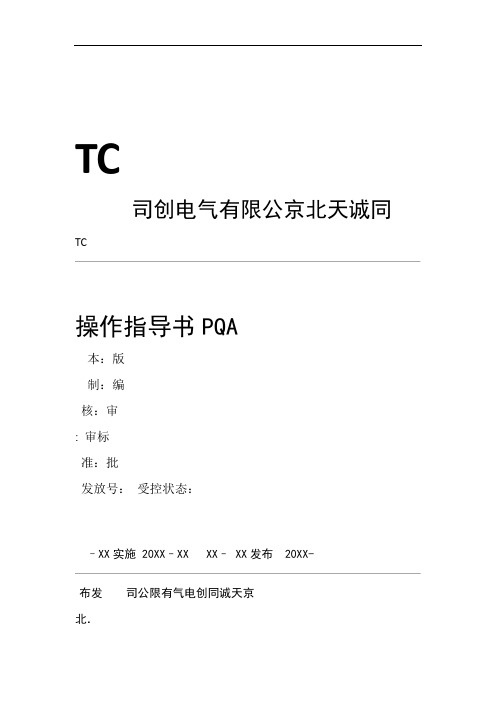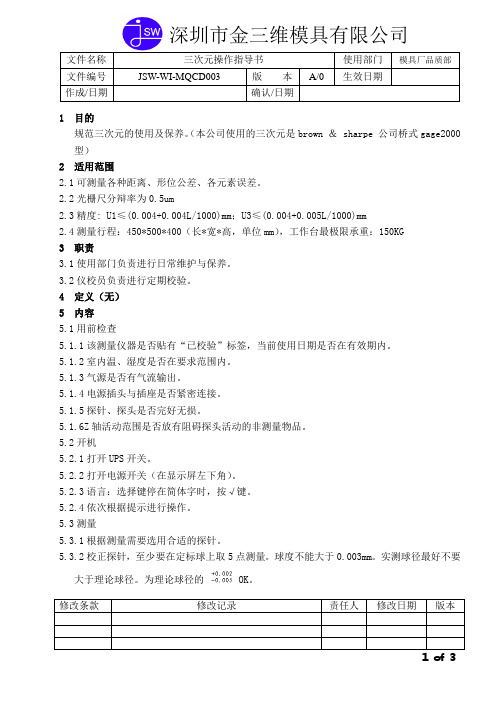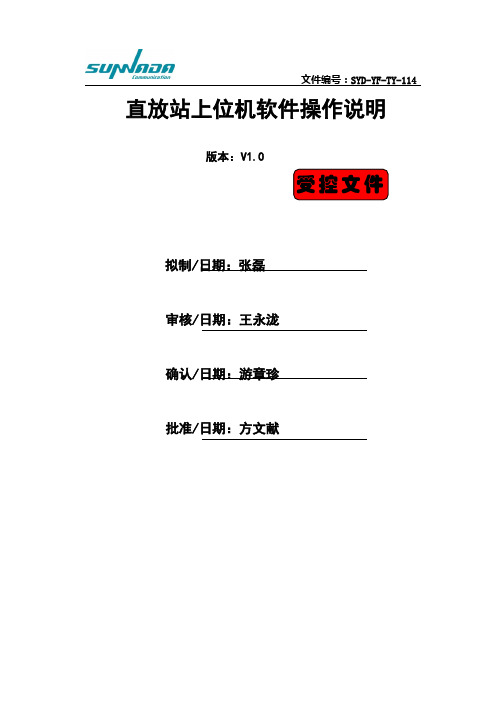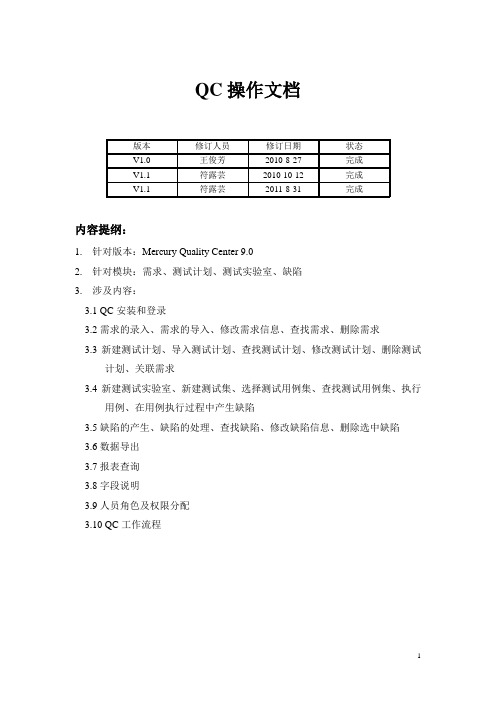QCA3.0黄荣贵编操作手册
QC测量基础高度规操作培训教材

6. 表盘测头, 指针对齐零点
四.校针操作步骤
五.F1-F4详细运用方法〔双碰点〕
六.F1-F4详细运用方法〔单碰点〕
七.电池改换
八.校针改换
九.本卷须知 1. 高度规在校正期内缺点,必需由校正单位修缮重新校正方可运用。 2. 测头量测时不能用力过猛,防止量测力形成误差。 3. 测头各构件必需锁紧,以免因松动形成测量误差。 4. 量测前必需校正测针,或确保测针是已校正的。 5. 高度规在搬动时,应尽量握底座。 6. 单向量测不用经过校正轨校正测头。开机后第一次归零,再一次归零按F2。 7. 双向量测时必需用校正轨校正前方可测量。 8. Error1-4显示时须清洁当学尺。Error4能够时位移过快。 9. Error6-8显示电子系统有效果。
QC测量基础高度规操作 培训教材
2021/6/30
一.用途目的
❖ 用途:直接量测高度、圆心距和段差等。
❖ 量具称号 :电子高度规,表盘高度规。
❖ 量具规格 :
❖
0 ~ 350 MM
❖
0 ~ 600 MM
❖ 解析度: 0.001 MM 或 0.0001 INCH
❖ 义务温湿度: 溫度20℃ ±5℃, 相對濕度45%~90%.
时说明仪器曾经将测针停止了补偿。 4. 依图面基准和被测样品特性,将样品装平于大理石平台,末尾停止量测。 5. 经过显示屏读取所要的数据。 6. 运用完后将高度规放回原位,并清算洁净平台。
三.高度规的详细操作步骤(二)
1. 预备校针
2. 停止校针
3. 校针界面
4. 校针OK
5. 量测时,切 勿用力过猛
十. 维护保养 1. 每天用仪器公用无水酒精清洗高度规和大理石平台。 2. 每天反省显示屏读数显示能否正常。 3. 每天反省各功用键能否正常,以及传动带移动正常。 4. 每周用100MM块规点检高度规。
PQA指导书

TC司创电气有限公京北天诚同TC操作指导书PQA本:版制:编核:审: 审标准:批发放号:受控状态:–XX实施20XX–XX XX–XX发布20XX-布发司公限有气电创同诚天京北.TC XXXXXXX录目................................................................................. I目录........................................................................ 1PQA 操作指导书 ...............................................................................11 目的 ...............................................................................12 范围 .........................................................................13 术语和定义....................................................................... 1 PQA工作职责 .4 (25)质量保证流程图................................................................. 4 PQA的主要活动说明 .6....................................................................... 4计划(Plan) .6.1............................................. 46.2引导和培训(Facilitating and training)活动说明 ....................................................... 57 产品开发全流程中PQA度量元及度量活动 (68)........................................................................... 6相关文件9 .................................................................. 610 形成的文件及记录ITC XXXXXXXPQA操作指导书目的1提高组织产出高为规范公司在项目过程中的质量保证活动,确保项目整个生命周期得到质量控制,质量产品的可信度。
QC080000程序文件--P-30QA运作管理程序

制定部门生产部制定日期2016-03-01 修改日期2019-9-1 页次1OF4QA运作管理程序1.目的1.1生产作业过程中,针对影响品质稳定客观条件的核查(如:外观检查、功能检查、电气性能、安规要求、包装检查、内部检查等),发现异常,及时纠正;1.2在产品批量生产过程中,及时地对成品进行抽检,确保产品质量满足客户要求,防止不合格成品入库或进入销售渠道。
2.适用范围适用于本公司所有成品检验的管理。
3. 定义3.1 产品技术资料产品相关设计资料,包括BOM、规格书、电路图、接线图、PCB图、产品操作说明、开发项目书、新产品评估报告、机械图、新产品测试报告、新产品确认表等。
3.2 作业指导书体现产品具体制作方法和制作要求的一份工艺资料。
是生产必须的生产作业标准。
4. 权责4.1品管人员4.1.1 QA负责对生产出的成品进行抽样检查,对产品的制程品质控制进行协助检查;4.1.2 品管经理负责统筹成品检验的过程,处理成品抽检中所发生的品质异常,具有质量判定的最终决定权。
5.抽样方法5.1最终目标:C=05.2实际抽样:按MIL-STD-105EⅡ级单次正常一般检验水平进行抽取样品。
AQL值:5.2.1致命缺陷(Critical)-------------0.0;5.2.2严重缺陷(Major)----------------1.5;5.2.3轻微缺陷(Minor)----------------4.0;5.3 如客户有特殊要求,则按客户指定的AQL值进行抽样检验。
6.使用仪器设备6-1.功率测试仪6-2.耐压测试仪6-3.泄漏电流测试仪6-4.噪音计6-5.拉力计6-6.探温仪6-7.秒表制定部门品管部制定日期2019-07-06 修改日期页次2OF4 6-8.测试夹具6-9.测试台6-10.扭力计6-11.游标卡尺6-12.盐雾测试仪6-13.高低温交变湿热试验箱6-14.安全性能综合测试仪6-15.变频电源6-16.跌落试验机6-17.模拟运输振动台6-18.数字存储示波器必要时增加其它必备的测试仪器。
[电力水利]3A使用手册
![[电力水利]3A使用手册](https://img.taocdn.com/s3/m/15e4655068eae009581b6bd97f1922791788be51.png)
1 测量仪器功能介绍 (3)技术指标 (4)越限保护功能 (4)仪器的面板说明及测量接线 (5)连接仪器和调制解调器 (6)开机 (6)操作说明 (6)1 测量运行 (6)2 参数设置 (9)仪器状态指示 (12)测量结果说明 (12)2 数据通讯软件介绍 (13)管理站点信息 (13)设置通讯参数 (15)接收站点的测量数据 (15)修改和接收站点的仪器参数 (16)实时接收站点的测量数据 (17)3 数据分析软件介绍 (18)设置数据文件的显示内容 (19)绘制任意时间段各分析对象的变化曲线 (20)绘制任意时间段各分析对象的分布图 (21)统计分析 (23)合格率计算 (24)打印 (26)保存 (26)设置文件的类型和所在的目录 (27)退出 (27)4 电能质量报表软件介绍 (28)工具条按钮 (28)5 日越限图表软件介绍 (32)工具条按钮 (32)使用说明 (33)测量仪器功能介绍本仪器是利用工业计算机,结合高速、高精度的采样系统,并配以丰富的软件而构成的功能强大的电能质量监测系统。
可单独装屏也可通过电话线和远端主计算机相连接组成网络,实现一对多点的监测分析。
DZ-3A 电能质量监测仪• 可测量三相电压、三相电流的谐波、序分量、电压变动和闪变、电压偏差、 功率因数、有功、无功、频率。
• 实时监测、定时记录(每五分钟记录一组测量结果,保存三个月)• 每月自动生成月统计报表,统计区间为上月25日至本月25日。
• 每天自动生成一个越限情况报告文件,记录着一天中各次谐波越限的起止 时间以及越限时刻的值。
• 具有谐波超值报警和跳闸功能。
• 仪器具备内置调制解调器及串口两种通讯模式,从而可构成监测网络。
后台分析软件• DZ—3A 数据通讯:用于修改、读入仪器的参数设置,接收各测量点任意时 间段的测量结果、月统计记录、日越限情况报告文件。
也可实时接收察看各监测点的测量数据,并可实时或越限记录。
MQCD003三次元操作指导书

JSW-WI-MQCD0031 目的规范三次元的使用及保养。
(本公司使用的三次元是brown & sharpe 公司桥式gage2000型) 2 适用范围2.1可测量各种距离、形位公差、各元素误差。
2.2光栅尺分辩率为0.5um2.3精度: U1≤(0.004+0.004L/1000)mm ;U3≤(0.004+0.005L/1000)mm 2.4测量行程:450*500*400(长*宽*高,单位mm ),工作台最极限承重:150KG 3 职责3.1使用部门负责进行日常维护与保养。
3.2仪校员负责进行定期校验。
4 定义(无) 5 内容 5.1用前检查5.1.1该测量仪器是否贴有“已校验”标签,当前使用日期是否在有效期内。
5.1.2室内温、湿度是否在要求范围内。
5.1.3气源是否有气流输出。
5.1.4电源插头与插座是否紧密连接。
5.1.5探针、探头是否完好无损。
5.1.6Z 轴活动范围是否放有阻碍探头活动的非测量物品。
5.2开机5.2.1打开UPS 开关。
5.2.2打开电源开关(在显示屏左下角)。
5.2.3语言:选择键停在简体字时,按√键。
5.2.4依次根据提示进行操作。
5.3测量5.3.1根据测量需要选用合适的探针。
5.3.2校正探针,至少要在定标球上取5点测量。
球度不能大于0.003mm 。
实测球径最好不要大于理论球径。
为理论球径的 OK 。
JSW-WI-MQCD0035.3.3探针校准后即可测量。
5.3.4在测量过程中,因为需要须更换探针时,需重新校准当前使用探针。
5.3.5测量过程中根据需要打开或关闭CMM左侧的气压调节旋纽,使3轴能在任意方向移动或停留,当3轴被锁定后可使用X、Y、Z三方向的微调旋纽,对探针进行任意方向微调。
5.3.6具体测量方法参照cmm使用说明书。
5.3.7测量完毕后,将Z轴移到安全的位置并锁定。
(左上角)5.4关机5.4.1清屏。
5.4.2直接关闭显示屏左下角的电源开关。
503说明书合订版本

CDA503系列产品使用说明-目录一、CDA503系列产品概述 (1)1.使用范围及条件 (1)2.特点 (1)3.外形尺寸 (1)4.运输、验收、存放、安装、维护 (1)二、CDA503电源单元 (1)1.主要功能及技术指标 (2)2.面板示意图 (2)1.主要功能及技术指标 (3)2.面板说明(面板功能按钮和指示灯的布置) (3)3.接线定义 (3)四、CDA503断路器控制单元 (4)1.主要功能及技术指标 (4)2.面板说明 (4)3.接线定义 (5)五、CDA503过流保护断路器控制单元 (5)1.主要技术指标 (5)2.主要功能 (5)3.面板说明 (5)4.LCD液晶显示及键盘操作 (6)5.接线定义7一、CDA503系列产品概述1.使用范围及条件海拔: 不大于2000m 环境温度: -25℃~+65℃相对湿度: 50%~95% 储存温度: -30℃~+85℃2、特点适用范围宽操作简便电机过流保护可远动控制合分闸操作抗震动、抗干扰能力强3.外形尺寸4.运输、验收、存放、安装、维护4.1 运输本产品必须包装运输, 不允许有强烈震动, 不允许倒置.4.2 验收(1)、开箱检查随机文件是否齐全....(2)、基本功能是否正常.注:随机文件..a.控制单元使用说明书一份.... b.合格证一份.4.3 存放产品应存放在室内清洁、干燥通风处, 存放时应小心, 谨防损坏.4.4 安全信息本产品为弱电设备, 但在现场安装、维护时, 附近有危险电压!本设备不能替代可见断开点, 工作时应遵循所在当地批准的安全规程;否则, 将因触高压导致严重人身伤亡.本手册并不能概括设备的安装、运行、维护等等的所有细节, 如有问题请与我公司联系.4.5安装步骤产品应安装在易操作的地方, 根据开关的位置的不同, 可安装在柱上的不同位置.安装步骤. (1)首先固定好控制单元.. (2)将外部接线接好.注: 本手册仅供参考, 如有更改, 恕不另行通知。
三元达直放站上位机软件操作说明资料

文件编号:SYD-YF-TY-114 直放站上位机软件操作说明版本:V1.0拟制/日期:张磊审核/日期:王永泷确认/日期:游章珍批准/日期:方文献受控文件目录前言 (3)名词注释 (3)1、软件概述 (4)1.1直放站监控系统概述 ........................................................ 错误!未定义书签。
1.2网管软件功能概述 ............................................................ 错误!未定义书签。
2、软件操作说明 (4)2.1软件安装 (4)2.2启动软件 (8)2.3直放站主界面介绍 (10)3、软件的基本操作 (18)3.1站点的建立 (18)3.2删除站点 (20)3.3建立连接 (21)3.4关闭连接 (28)4、整机调试的软件应用 (29)4.1A型设备的调试 (29)4.2B型设备的调试 (38)前言本用户手册主要介绍了福建三元达通讯股份有限公司直放站网管软件产品的功能和操作方法。
主要面向具有WINDOWS基本应用能力的人员,供用户及相关操作人员作为操作指导使用。
此版本说明只适用现阶段监控产品,今后监控产品升级应需遵循新版本操作说明。
应用范围如下:1、模块生产调试以及整机设备生产调试。
2、工程设备安装维护调试。
3、用户网管OMC设备远程监控查询以及参数变更。
名词注释硬件类型用于区分公司不同硬件平台的监控产品。
主要区别于调试操作方式不同。
A型:主要包括采用V7.X系列(MEGA)平台、8.X系列(ARM7)平台的监控老平台设备。
一般使用在旧版常规设备以及3代DRRS数字设备。
B型:指采用M3硬件平台的监控设备。
今后新开发产品都采用此类型工作,目前使用在新版M3平台常规干线放大器、光纤站常规设备以及4代DRRS数字设备以及今后旧设备的升级优化。
协议类型设备采用的监控协议;详细由运营商规定正常模式完全参照协议工作的方式,A型设备所有生产/工程调试时在正常模式进行;工程模式只在B型硬件类型状态下有效,A型硬件类型无法使用;B型硬件类型设备,在此模式下进行工程开通调试/维护。
QC最全的操作手册

QC10.0操作手册目录项目管理员操作部分 (5)一、Management (5)1.1、创建Release及Cycle (5)1.1.1、创建Release文件夹 (6)1.1.2、创建Release (6)1.1.3、创建Cycle (7)1.1.4、复制Cycle (8)1.1.5、删除Release folder 、Release、Cycle (9)二、Requirements (9)2.1、创建需求 (10)2.1.1、创建Requirements文件夹 (11)2.1.2、创建Requirements (11)2.1.2.1、Details (11)2.1.2.2、Requirements Traceability (12)2.1.2.3、Test Coverage (13)2.1.2.4、Linked Defects (13)2.1.2.4.1 通过ID关联BUG (14)2.1.2.4.2通过选择关联 (14)2.1.2.4.3、创建BUG (15)2.1.2.4.4、删除关联 (16)2.1.3、删除Requirements及其文件夹 (16)三、Dashboard (16)3.1、Private (16)3.1.1、创建Private文件夹 (16)3.1.2、创建Dashboard (16)3.1.2.1、Graph Wizard (17)3.1.2.2、New Graph (20)3.1.2.3、New Standard Report (22)3.1.2.4、New Excel Report (23)3.1.2.4.1 Query Builder (24)3.1.2.4.2 Generation Setting (25)3.1.2.4.3 Generate (26)3.1.3、Dashboard Veiw (26)3.1.3.1、New Page (26)3.2、Public (28)测试人员操作部分 (28)一、Test Plan (28)1.2、创建Test Plan (29)1.1.1、创建Test Plan文件夹 (30)1.1.2、创建测试用例 (30)1.1.2.1、Details (30)1.1.2.2、Design Steps (31)1.1.2.2.1添加Test Step (31)1.1.2.2.1.1、Description相关功能 (32)1.1.2.2.1.2、查看其他Test Step (33)1.1.2.2.1.3、删除Test Step (33)1.1.2.2.2修改/查看Test Step (33)1.1.2.2.3为Test Step 排序 (34)1.1.2.2.4删除Test Step (34)1.1.2.2.5复制、粘贴Test Step (34)1.1.2.3、Test Script (34)1.1.2.4、Attachments (35)2.1.2.3、Req Coverage (35)1.1.2.4、Linked Defects (35)1.1.2.4.1 通过ID关联BUG (36)1.1.2.4.2通过选择关联 (36)1.1.2.4.3、创建BUG (37)1.1.2.4.4、删除关联 (38)1.1.2.4.5、查看历史信息 (38)1.3、修改Test Plan (38)1.4、导出Test Plan (39)1.3.1、列显示 (39)1.3.2、导出Test plan (40)1.3.3、转到Test Plan Tree (41)1.5、导入Test Plan (41)1.6、Go To Test (45)二、Test Lab (45)2.1、创建Test Plan (45)2.1.1、创建Test Lab文件夹 (46)2.1.2、创建Test Set (47)2.1.2.1、Details (48)2.1.2.2、Execution Grid (48)2.1.2.2.1Select Tests (49)2.1.2.2.2Run (49)2.1.2.2.2.1、Begin Run (50)2.1.2.2.2.1.1、快速添加Test Step (51)2.1.2.2.2.1.2、快速删除Step (52)2.1.2.2.2.1.3、Pass selected (52)2.1.2.2.2.1.4、Fail Selected (53)2.1.2.2.2.1.6、Filter By (53)2.1.2.2.2.2、End Run (53)2.1.2.2.2.3、Cancel Run (53)2.1.2.2.2.4、BUG管理 (53)1.1.2.2.3Run Test Set (53)1.1.2.2.4删除Test Set (54)1.1.2.3、Execution Flow (54)2.1.2.4、Attachments (54)2.1.2.5、Linked Defects (54)1.1.2.4.1 通过ID关联BUG (55)1.1.2.4.2通过选择关联 (55)1.1.2.4.3、创建BUG (56)1.1.2.4.4、删除关联 (57)1.1.2.4.5、查看历史信息 (57)2.2、列显示 (57)三、Defects (58)3.3、BUG生命周期 (59)3.4、新建BUG (60)3.2.1、填写BUG信息 (60)3.2.2、BUG字段描述 (60)3.2.3、严重等级划分 (61)3.5、修改/查看BUG (61)3.3.1、修改/查看当前BUG信息 (62)3.3.2、修改/查看其他BUG信息 (62)3.3.3、添加附件 (62)3.3.4、关联 (63)3.3.4.1、添加关联 (64)3.3.4.2、删除关联 (65)3.3.4.3、快速进入关联BUG (65)3.3.5、查看历史信息 (65)3.6、删除BUG (66)3.7、列显示 (66)开发人员操作部分 (67)一、Defects (67)1.1、查看指派给自己的BUG (68)1.2、修改BUG状态 (69)1.3、添加附件 (70)1.4、关联 (71)1.5、查看历史信息 (72)项目管理员操作部分一、ManagementManagement模块主要是对Release和Cycle的管理。
QI-QA-0030QA测试作业指导书

1、制定修改履历:2、传阅及培训:1 .参照标准1.1 抽样标准按照国标GB/T2828.1-2003一次抽样II 类允许水准AQLC=0MAJ=0.65MIN=2.5 1.2 本公司《成品通用标准》 2 .作业内容2.1 取出手机检查手机外观,标准根据《成品通用标准》执行;2.2 插移动/联通卡、装电池开机确认开机铃声有无杂音、无声、电流声、断续、沙哑,检查背光灯是否显示正常,看显示屏是否有显示竖条、缺行、少图标、背光灯不亮等不良现象,确认SIM 卡信号格是否是时有时 无等现象;有无不识主卡或不识从卡等现象;2.3 点击“设置”内对手机进行屏幕校准(对触摸屏手机进行此项测试),并进入“通话设置”查看通话记录是否清零;2.4 进入CIT 进行测试,详情t 青见《各机型CIT 测试内容》进行操作;2.5 测试MP3/4播放功能;选择“菜单”中的“多媒体”进入“音乐播放机/动画播放器”对“清单”中的歌曲进行播放,检测MP3/4歌曲能否正常播入,声音不可有沙哑、断续、杂音、电流声现象,MP3/4 清单中的歌曲是否有多或少项目。
(在播放时插上耳机进行测试,听耳机声音是否正常有无单边响等现 象)2.6摄像功能;选择“菜单”中的“多媒体”进入“照相机”点击确认看是否照相正常有无照相花屏、白屏、照相异常、亮点现象;拍照后进行保存查看照片有无花屏、白屏、亮点、横竖条现象;确认OK 后 删除相片;2.7 录影功能:选择“菜单”中的“录影播放器”点击确认进行录像,看是否录像正常有无录像花屏死机、白屏、等现象; 2.8 用移动卡拨打10086/联通卡拨打10010对主卡与从卡/小灵通卡进行拨打电话,通话连接不能出现“无发联机”现象,通话时确认听筒处不能有无发联机、电流声、无声、沙哑、杂音、音小、屏闪、断续现象(同时插上耳机对耳机通话进行测试,听耳机声音不能有无发联机、电流声、无声、沙哑、杂音、音小、断续,屏闪、耳机单边响,用耳机按钮挂断通话)测试通过后删除通话记录同时将通话记录清零;2.9 a :进入“附加功能”激活蓝牙功能,手机待机画面左上方出现一个蓝色符号(表示已经启动了蓝牙功能);b :进入“附加功能”在蓝牙功能中选择“我的装置”进行测试,使用两部手机同时进行装置搜索配对,互相搜索到对方后两部手机会同时出现一个输入密码画面,输入密码四个零进行确认连接,进入“我 的装置”选项中可以看到配对后出现的序号,点击“全部删除”进行归零;c :进入“附加功能”在蓝牙功能中选择“搜寻免持装置”,用准备好的蓝牙耳机同时与手机进行搜索配对,当手机搜索到耳机后手机的左上方蓝色符号变为绿色符号,表示手机与耳机已经进行连接,拨打“10086”进行通话转换蓝牙耳机进行测试,在通话中听耳机有无杂音、断续、无声、声音小等现象,通话结束后用耳机进行挂断通话。
RANGER 3 三相操作员手册说明书

RANGER ®3 PHASEFor Machines with Code Number 11619IM10030November, 2010Safety Depends on YouLincoln arc welding and cutting equipment is designed and built with safety in mind. However,your overall safety can be increased by proper installation ...and thoughtful operation on your part.DO NOT I NSTAL L,O PERATE O R REPAI R THI S EQ UI PM ENT W I THO UT READ-I N G TH I S M ANU AL AN D TH E SAFETY PRECAUTI O NS CO N-TAI NED THROUGHO UT.And,most importantly, think before you act and be careful.Copyright © Lincoln Global Inc.SECTION A:WARNINGSC ALIFORNIA PROPOSITION 65 WARNINGSWARNING: This product, when used for welding or cutting, produces fumes or gases which contain chemicals known to the State of California to cause birth defects and, in some cases, cancer. (California Health & Safety Code § 25249.5 et seq.)ARC WELDING CAN BE HAZARDOUS. PROTECTYOURSELF AND OTHERS FROM POSSIBLE SERIOUS INJURY OR DEATH. KEEP CHILDREN AWAY.PACEMAKER WEARERS SHOULD CONSULT WITH THEIR DOCTOR BEFORE OPERATING.Read and understand the following safety highlights. For additional safety information, it is strongly recommended that you purchase a copy of “Safety in Welding & Cutting - ANSI Standard Z49.1” from the American Welding Society, P.O. Box 351040, Miami, Florida 33135 or CSA Standard W117.2-1974. A Free copy of “Arc Welding Safety” booklet E205 is available from the Lincoln Electric Company, 22801 St. Clair Avenue, Cleveland, Ohio 44117-1199.BE SURE THAT ALL INSTALLATION, OPERATION,MAINTENANCE AND REPAIR PROCEDURES ARE PERFORMED ONLY BY QUALIFIED INDIVIDUALS.FOR ENGINE POWERED EQUIPMENT.1.a.Turn the engine off before troubleshootingand maintenance work unless themaintenance work requires it to be running.1.b.Operate engines in open, well-ventilated areas or vent the engineexhaust fumes outdoors. 1.c.Do not add the fuel near an open flame weldingarc or when the engine is running. Stop the with hot engine parts and igniting. Do not spill fuel when filling tank. If fuel is spilled, wipe it up and do not start engine until fumes have been eliminated.1.d. Keep all equipment safety guards, coversand devices in position and in good repair.Keep hands, hair, clothing and tools away from V-belts, gears, fans and all other moving parts when starting, operating or repairing equipment.1.e.In some cases it may be necessary to remove safety guards toperform required maintenance. Remove guards only when necessary and replace them when the maintenance requiring their removal is complete. Always use the greatest care when working near moving parts. 1.f. Do not put your hands near the engine fan. Do not attempt tooverride the governor or idler by pushing on the throttle control rods while the engine is running. 1.g.To prevent accidentally starting gasoline engines while turningthe engine or welding generator during maintenance work,disconnect the spark plug wires, distributor cap or magneto wire as appropriate. 1.h.To avoid scalding, do not remove the radiatorpressure cap when the engine is hot.ELECTRIC ANDMAGNETIC FIELDS MAY BE DANGEROUS2.a.Electric current flowing through any conductorcauses localized Electric and Magnetic Fields (EMF).Welding current creates EMF fields around welding cables and welding machines 2.b.EMF fields may interfere with some pacemakers, andwelders having a pacemaker should consult their physician before welding. 2.c.Exposure to EMF fields in welding may have other health effectswhich are now not known. 2.d.All welders should use the following procedures in order tominimize exposure to EMF fields from the welding circuit:2.d.1.Route the electrode and work cables together - Securethem with tape when possible.2.d.2.Never coil the electrode lead around your body.2.d.3.Do not place your body between the electrode and workcables. If the electrode cable is on your right side, the work cable should also be on your right side.2.d.4.Connect the work cable to the workpiece as close as pos-sible to the area being welded.2.d.5.Do not work next to welding power source.SAFETYWELDING OUTPUT CAbLESWith the engine off, connect the electrode and work cables to the studs provided. These connections should be checked periodically and tightened if neces-sary. Loose connections will result in overheating of the output studs.When welding at a considerable distance from the welder, be sure you use ample size welding cables. Listed below are copper cable sizes recommended for the rated current and duty cycle. Lengths stipulated are the distance from the welder to work and back to the welder again. Cable sizes are increased for greater lengths primarily for the purpose of minimizing cable voltage drop.ANGLE OF OPERATIONInternal combustion engines are designed to run in a level condition which is where the optimum perfor-mance is achieved. The maximum angle of operation for the engine is 15 degrees from horizontal in any direction. If the engine is to be operated at an angle, provisions must be made for checking and maintain-ing the oil at the normal (FULL) oil capacity in the crankcase in a level condition.When operating at an angle, the effective fuel capacity will be slightly less than the specified 12 Gal. (45 L). LIFTINGThe RANGER® 3 PHASE weighs approximately 587lbs. (266.3kg) with a full tank of gasoline. A lift bail is mounted to the machine and should always be used when lifting the machine.ADDITIONAL SAFETY PRECAUTIONAt higher altitudes, Welder output de-rating may be necessary. For maximum rating, de-rate the welder output 3.5% for every 1000 ft. (305m) above 3000 ft. (914m). If operation willconsistently be at altitudes above 5,000 ft. (1525m), a carburetor jet designed for high altitudes should be installed. This will result in better fuel economy, cleaner exhaust and longer spark plug life. It will not give increased power. Contact your local authorized engine service shop for high altitude jet kits that are available from the engine manufacturer.Do not operate with a high altitude jet installed at altitudes below 5000 ft. (1525m). This will result in the engine running too lean and result in higher engine operating temperatures which can shorten engine life.------------------------------------------------------------------------MUFFLER OUTLET PIPEUsing the clamp provided secure the outlet pipe to the outlet tube with the pipe positioned such that it will direct the exhaust in the desired direction. Tighten using a 9/16” socket or wrench.TABLE lllELECTRICAL DEVICE USE WITH THE RANGER® 3 PHASE.Type Common Electrical Devices Possible Concerns ResistiveHeaters, toasters, incandescent NONElight bulbs, electric range, hot pan, skillet, coffee maker.CapacitiveTV sets, radios, microwaves, Voltage spikes or high voltageappliances with electrical control.regulation can cause the capacitative elements to fail. Surge protection,transient protection, and additional loading is recommended for 100%fail-safe operation. DO NOT RUN THESE DEVICES WITHOUT ADDI-TIONAL RESISTIVE TYPE LOADS.InductiveSingle-phase induction motors, These devices require large drills, well pumps, grinders, small current inrush for starting.refrigerators, weed and hedge Some synchronous motors may trimmersbe frequency sensitive to attain maxi-mum output torque, but they SHOULD BE SAFE from any frequency induced failures.Capacitive/InductiveComputers, high resolution TV sets,An inductive type line condition-complicated electrical equipment.er along with transient and surge pro-tection is required, and liabilities still exist. DO NOT USE THESE DEVICES WITH A RANGER® 3PHASEThe Lincoln Electric Company is not responsible for any damage to electrical components improperly connected to the RANGER® 3PHASE.MOTOR STARTINGMost 1.5 hp AC single phase motors can be started if there is no load on the motor or other load connected to the machine,since the full load current rating of a 1.5 hp motor is approxi-mately 20 amperes (10 amperes for 240 volt motors). The motor may be run at full load when plugged into only one side of the duplex receptacle. Larger motors through 2 hp can be run provided the receptacle rating as previously stated is not exceeded. This may necessitate 240V operation only.The 480 volt 3 phase output of the RANGER 3 PHASE is capa-ble of running most 480VAC 3 phase motors up to 10HP. A 10HP motor must be started with no load on the motor and no other load connected to the machine, since the full load current of a 10HP 480VAC 3 phase motor is approximately 12.5 amps.Refer to the reconnect phase output to any load, the ground at the 3 phase receptacle is NOT the neutral of 3 phase connec-tion, and should under no circumstance be connected to the neutral of any 3 phase load.1.Install a double pole, double throw switch betweenthe power company meter and the premises dis-connect.Switch rating must be the same or greater than the customer’s premises disconnect and service over-current protection.2.Take necessary steps to assure load is limited tothe capacity of the RANGER® 3 PHASE by installing a 40 amp 240V double pole circuit break-er. Maximum rated load for the 240V auxiliary is 40 amperes. Loading above 40 amperes will reduce output voltage below the allowable -10% of rated voltage which may damage appliances or other motor-driven equipment.3.Install a 50 amp 120/240V plug (NEMA type 14-50)to the Double Pole Circuit Breaker using No. 8, 4 conductor cable of the desired length. (The 50 amp 120/240V plug is available in the optional plug kit.)4.Plug this cable into the 50 amp 120/240V recepta-cle on the RANGER® 3 PHASE case front.Diameter Wire Speed Approximate (in.) Range In./Min. Current Range .03075 - 30050A to 130A.035100 - 25090A to 175AhOW TO USE TROUbLEShOOTING GUIDEJapaneseChineseKoreanArabicREAD AND UNDERSTAND THE MANUFACTURER’S INSTRUCTION FOR THIS EQUIPMENT AND THE CONSUMABLES TO BE USED AND FOLLOW YOUR EMPLOYER’S SAFETY PRACTICES.SE RECOMIENDA LEER Y ENTENDER LAS INSTRUCCIONES DEL FABRICANTE PARA EL USO DE ESTE EQUIPO Y LOS CONSUMIBLES QUE VA A UTILIZAR, SIGA LAS MEDIDAS DE SEGURIDAD DE SU SUPERVISOR.LISEZ ET COMPRENEZ LES INSTRUCTIONS DU FABRICANT EN CE QUI REGARDE CET EQUIPMENT ET LES PRODUITS A ETRE EMPLOYES ET SUIVEZ LES PROCEDURES DE SECURITE DE VOTRE EMPLOYEUR.LESEN SIE UND BEFOLGEN SIE DIE BETRIEBSANLEITUNG DER ANLAGE UND DEN ELEKTRO-DENEINSATZ DES HERSTELLERS. DIE UNFALLVERHÜTUNGSVORSCHRIFTEN DES ARBEITGEBERS SIND EBENFALLS ZU BEACHTEN.JapaneseChineseKoreanArabicLEIA E COMPREENDA AS INSTRUÇÕES DO FABRICANTE PARA ESTE EQUIPAMENTO E AS PARTES DE USO, E SIGA AS PRÁTICAS DE SEGURANÇA DO EMPREGADOR.。
美国UC3-CT-A平衡器用户手册说明书

R e t a i l S c a l e sA logical merger of PC and scaleThe UC3-CT-A is a high-performance scale of the latest generation of UCs, focusing on users and customers. touchscreen, which is freely customisable in all respects, incorporates these aspects Our flat series saves space and provides UC3-CT-ATechnical dataUC3-CT-ACapability CharacteristicsOnline help: Operative assistance via text displays Competence text for the operatorReceipt reversal via the receipt number Extensive taring options Proof of origin (optional)Promotions (optional)Receipt enhancement (optional)Cash register modules (optional)• Cash register functions • Coin count**DisplayMonochrome STN display, VGA resolution 320 x 240 pixels Colour STN display, VGA resolution 320 x 240 pixels (optional)The display is made for the operator via a 10.4-inch colour touch-screen (resolution 800 x 600)Weight display with 5 characters 5-character tare displayFlat rate display with 8 charactersTotal amount display with 9 characters3-line text display, 20 characters per line (customer page)Coloured texts advertising on the customer displayOperation typesOperation, labelling, bulk, operation with receipt and total label, receipt and article label, stick-on total receipts, receipt with/without counterfoil Classic – by inputting the PLU number, via presets or via alphanumeric search functions, hits can be posted immediately Freely definable user layoutsPrinterChoose from a 2“ or 3“ label printer and 2“ receipt printer (standard)Possible as a 2“ linerless printer Fast label printer, up to 125 mm/s Logo printing onto receipt or labelFreely definable labels (for free designing of the labels on the PC, we offer our WYSIWYG program UC3 Label)Data MemoryMin. 40 GB hard disk256 MB RAM, 512 MB optionalSecurityPassword protection for important functions Local core database** only in combination with cash register functions/retailMore InformationQuality management certificate ISO 9001Environmental management certificate ISO 14001Internet: Worldwide ServiceSubject to technical changes ©082007 Mettler-Toledo GmbH Printed in Germany 22014468MCG MarCom GreifenseeMultimedia web support Flash Player (optional)InterfacesEthernet TCP/IP 10/1001 x RS232 serial interface1 x RJ11 interface for triggering of a cash register drawer2 x USB 2.0 connections Optional:Wireless solution according to IEEE 802.11b/g Remote service/control and data supply FTP VNCData communication via Trans UC3Data supply and disposal via XML interfaceOperating SystemMicrosoft Windows Embedded for Point Of Service (WEPOS)Linux (optional)Weighing area 6kg 15kg 3kg/6kg6kg/15kg 12kg 30kg Division 2g 5g 1g/2g 2g/5g 2g 5g Min. load* 40g 100g20g40g40g100g* EC: Printing is possible for the minimum load, however not when labelling. Taring comparison throughout the entire weighing area; automatic zeroposition.• Outstanding ergonomics – thanks to adjustment options for the customer display and touchscreen• Alphanumeric searching – just a few letters to the target of generating additional sales• Cross-selling at a high level universal networking capability; via wifi (WLAN) optionally available。
QC用户操作手册

QC操作文档内容提纲:1. 针对版本:Mercury Quality Center 9.02. 针对模块:需求、测试计划、测试实验室、缺陷3. 涉及内容:3.1 QC安装和登录3.2需求的录入、需求的导入、修改需求信息、查找需求、删除需求3.3新建测试计划、导入测试计划、查找测试计划、修改测试计划、删除测试计划、关联需求3.4新建测试实验室、新建测试集、选择测试用例集、查找测试用例集、执行用例、在用例执行过程中产生缺陷3.5缺陷的产生、缺陷的处理、查找缺陷、修改缺陷信息、删除选中缺陷3.6数据导出3.7报表查询3.8字段说明3.9人员角色及权限分配3.10 QC工作流程目录QC操作文档 (1)目录 (2)1.安装和登录 (4)1.1 安装 (4)1.2 登录 (7)2.需求模块 (9)2.1需求模块简介 (9)2.1.1 定义显示列 (10)2.1.2 重排列名显示顺序 (11)2.2新建需求 (12)2.2.1 新建需求 (12)2.2.2 需求录入 (13)2.2.3 附件文件 (13)2.2.4 提交 (15)2.3导入需求 (15)2.3.1插件安装 (16)2.3.2需求项添加 (16)2.3.3导入按钮 (16)2.3.4导入步骤 (17)2.3.5查看(修改)需求详细信息 (21)2.3.6查找需求 (21)2.3.7删除需求 (24)3.测试计划 (24)3.1新建测试用例 (24)3.1.1新建测试用例 (24)3.2导入测试用例 (27)3.3需求转换成测试计划、测试用例、测试步骤 (28)3.4查找测试计划 (32)3.4.1调整测试计划视图 (33)3.4.2设置筛选条件 (33)3.4.3切换回树状结构 (33)3.5修改测试计划 (34)3.6删除测试计划 (34)4.测试实验室 (35)4.1新建测试文件夹 (35)4.2新建测试集 (36)4.3选择测试用例集 (37)4.4查找测试用例 (37)4.5执行测试用例 (37)4.5.1选择测试用例并运行 (37)4.5.2设置运行结果 (38)4.5.3结束运行 (39)4.5.4查看运行结果 (39)4.6用例执行中产生缺陷 (40)4.6.1点击新建缺陷按钮 (40)4.6.2填写缺陷详细信息 (40)4.6.3提交缺陷 (41)4.6.4查看缺陷信息 (42)5.缺陷模块 (42)5.1缺陷的产生 (42)5.1.1新建缺陷 (42)5.1.2提交缺陷 (43)5.2缺陷的处理 (43)5.3查找缺陷 (46)5.4修改选中缺陷 (47)5.5删除选中缺陷 (47)6.数据导出 (48)6.1 将视图设置成网格结构 (48)6.2 设置导出列和导出列显示顺序 (49)6.2.1 点击选择列按钮 (49)6.2.2 进行列设置 (49)6.3 选择导出内容 (50)6.4 导出 (50)6.4.1 选择导出 (50)6.4.2 保存文件 (51)6.4.3 修改文件名后缀 (51)6.5 查看导出内容 (51)6.6 恢复树形结构 (52)7.报表查询 (52)7.1 进入分析页面 (52)7.2 图表简介 (53)7.3 变更查询条件并刷新 (54)7.4 设置分析对象 (55)8.字段说明 (56)8.1 需求模块 (56)8.2 缺陷模块 (57)8.3 注意事项 (62)9.人员角色及权限安排 (63)10.工作流程 (63)10.1总流程 (63)10.2缺陷流转 (63)10.2.1简要图 (63)10.2.2详细流程图 (64)产品及涉及名词解释:QC简介:Quality Center(以下简称QC)是Mercury公司开发的一款专业软件测试管理工具,后被HP公司所收购。
常用电子、电器元件检验规范操作指导书

2.3.1.3.产品批量小且为非破坏性检验时,可全数检验;产品批量大时,可抽样检验。
2.3.1.4.生产过程失控,产品质量低或波动大时,可全数检验(非破坏性);生产过程受控,产品质量高且稳定时,可抽样检验。
2.3.1.5.产品的关键、重要特性若不合格,则产品转入下道工序或在使用中将导致致命后果或会造成重大损失,此类特性应全数检验;一般件、一般特性,可抽样检验。
2.5.4. D:批中的不合格品数或不合格数;
2.5.5. N:批量;
2.5.6. n:样本量;
2.5.7. CL:样本量字码
2.6.正常、加严和放宽检验
2.6.1.检验开始
标记
处数
文件号
签字
日期
标记
处数
文件号
签字
日期
标记
处数
文件号
签字
日期
常用电子电器元件检验规范操作指导书
DD0.213.001
共51张
DD0.213.001
共51张
第4张
4.检验内容
4.1.原物料清单
序号
品名
页码
序号
品名
页码
序号
品名
页码
1
蜂鸣器
5
41
合格标签/回收标识
17
81
2
互感器
5
42
铭牌
18
82
3
变压器
6
43
说明书
18
83
4
继电器
6
44
包装盒/包装箱
18
84
5
液晶
QC操作手册

QC操作手册2010年1月目录1.编写目的 (2)2.QC状态流程 (2)3.QC状态的说明 (2)4.操作流程 (3)4.1.提出问题 (3)4.2.处理问题 (3)4.3.回归问题 (4)1.编写目的运用QC可以集中管理缺陷,对BUG进行实时的跟踪,测试出的BUG可以快速传递给开发,并提高开发与测试对BUG的互动。
2.QC状态流程状态流程图如下图:蓝色表示开发可做的动作,其它为测试可做的动作所有人都具有分配权限,其它权限如下:测试人员:新建固定->重新打开固定->关闭已否决->关闭测试负责人:新建->确认新建->无效已否决->重新打开开发人员:确认->延期确认->已否决确认->打开打开->修复打开->延期修复->固定延期->打开重新打开->修复重新打开->延期3.QC状态的说明开发人员处理状态:固定:bug已经被解决,并且通过经过测试。
已否决:被描述的问题不是一个bug(测试人员提出这个bug,但是开发人员认为不是bug)。
延期:被描述的问题是一个bug,但是不准备进行修改。
打开:被描述的问题是一个bug,正在进行修改。
修复:被描述的bug已经修改完成,还没有进行打包。
测试人员处理状态:新建:测试人员录入一个新bug时,这个就是第一个默认初始状态,而开发人员看到这个状态时bug,就知道这是一个新引入的bug。
确认:当一个bug被指认为新建之后,由测试负责人确认这是不是个bug,当确认后,开发人员才能对bug进行修改。
无效:当一个bug被指认为新建之后,由测试负责人确认这是不是个bug,如果不是 bug,把状态变为无效重新打开:开发人员固定之后,但是经过测试他的这个bug仍然没有被解决。
关闭:bug已经被解决,解决方案是被认为是正确的。
4.操作流程4.1.提出问题1、测试发现BUG,在QC上新建一个BUG, BUG的状态为“新建”状态。
COFANQC技能手册

编号:BI-003版本:A/1 页次:1/44日期:February 4, 2020技 能 手 册编号:BI-003版本:A/1 页次:3/44日期:February 4, 2020其它各个投影面如箭头所指方向,逐步展开到与正投影面在同一个平面上。
展开后的视图位置如图3-2所示。
当六个基本视而不见图的位置,如图3-2布置时,一律不标注视图名称。
六视图的投影对应关系:六视图的度量对应关系,仍保持“三等”关系,即主、左、后、右视图等高;左、右、俯、仰视图等宽;主、后、俯、仰视图等长。
六视图的方位对应关系,除后视图外,其他视图在“远离主视图”的一侧,均表示物体的前面部分。
图3-2:六个基本视图(2)第三角度法三个互相垂直的投影面V ,H ,W ,将W 面左侧空间划分为四个区域,按顺序分别称为第一角、第二角、第三角、第四角,如图3-3所示。
例如将产品放在第一角中,使机件处在观察者和投影面之间进行投影,这样得到的视图,称为第一角度法。
另一种方法是将产品放在第三角中,假设投影面是透明的,使投影面处在观察者和机件之间进行投影,这样得到期的视图,称为第三角度法,如图3-4所示。
图3-3:四个角 图3-4:三视而不见图的形成宽宽高长长H V W技 能 手 册编号:BI-003版本:A/1 页次:5/44日期:February 4, 2020第三角度法中的三视图三视图的形成按第三角度法,将物体放在三个相互垂直的透时投影面中,就象隔着玻璃看东西一样,在三个投影面上将得到三个视图(图3-4):从前向后投影,在正平面V上所得到的视图,称为前视图。
从上向下投影,在水平面H上所得到的视图,称为顶视图。
从右向左投影,在侧平面W上所得到的视图,称为右视图。
(3)剖视图当产品内形比较复杂时,在视图上就会出现许多虚线,这样给看图和标注尺寸都带来了不便,因此,为了清楚地表达产品的内部结构形状,用将产品剖视的方法来表达。
用一剖切平面,通过产品的对称中心线,把产品剖开,将处在观察者和剖切平面之间的部分移去,而将其余部分向投影面投影,这样得到的图形叫做剖视图,简称剖视。
- 1、下载文档前请自行甄别文档内容的完整性,平台不提供额外的编辑、内容补充、找答案等附加服务。
- 2、"仅部分预览"的文档,不可在线预览部分如存在完整性等问题,可反馈申请退款(可完整预览的文档不适用该条件!)。
- 3、如文档侵犯您的权益,请联系客服反馈,我们会尽快为您处理(人工客服工作时间:9:00-18:30)。
Qualitative Comparative Analysis using QCA3Ronggui HuangApril27,20141IntroductionQCA3can do various types of qualitative comparative analysis,namely crisp set QCA,fuzzyset QCA and multi-value QCA.It allows inclusion of simplifying assumptions and can produce intermediate solutions.All examples in Rihoux and Ragin(2009)can be reproduced by QCA3package.To reproducethe following examples,you need to load the QCA3packagefirst by>library(QCA3)2Crisp set QCABefore conducting crisp set QCA(csQCA)with QCA3,you need to import your dataset into R.Ifyour data is in Excel format,I would recommend you to export the data to a csvfile and importthe csvfile into R by read.csv function.In this article,all datasets are shipped with the QCA3 package,thus I will skip the steps of data import.In crisp set QCA(csQCA),all variables are binary(0or1).The dataset in this example isLipset cs.Thefirst step is to construct a truth table.You can use the function of cs truthTableto do it.>(cst<-cs_truthTable(Lipset_cs,outcome="SURVIVAL",+condition=c("GNPCAP","URBANIZA","LITERACY","INDLAB","GOVSTAB"), +cases="CASEID"))configuration distribution01Sum639case distributionOUT NCase01018=====GNPCAP URBANIZA LITERACY INDLAB GOVSTAB NCase freq1freq0OUT122000003030131001002020159101101010162111101010203000012020212001011010213101012201240101112201243111114401Cases122GRE,POR,SPA131HUN,POL159AUS162GER203ITA,ROM212EST213FIN,IRE240FRA,SWE243BEL,CZE,NET,UKThe above command constructs a truth table and assigns it to an object called cst,which can be used in the following analyses.You can choose any legitimate object name to store the produced truth table as long as it is a legitimate name in R.In this command,Lipset cs is the data frame which contains all the variables.The argument of outcome specificifies the explained variable,say”SURVIVAL”in this example(note that you need to enclose SURVIVAL with quotation mark).The argument of condition specificies the explanatory variables.It is a string vector,each element of which is a condition or explanatory variable.At least two conditions are needed.In this example,five conditions are provided.All variables,be outcome or conditions,are in the data frame of Lipset cs.For more details,you can refer to the help page of cs truthTable.The truth table is constructed by cs truthTable in an automatic manner.However,you can also manually override the outcome by function of setOUT,but I will not go through the details here.At this moment,you need to examine the truth table closely.Perhaps,it is a good idea to make connections between the truth table and the detailed empirical evidence about each case.Special attention should be paid to contradictory configurations,and you need to to handle such contradictory configurations if any.Once you have a truth table without contradictory configuration or you have come up a strategy to handle them,you can move to the next step, minimization of the truth table without remainders.All you need to d is to pass the truth table, cst,produced previously,to the reduce function.>reduce(cst)Call:reduce(x=cst)----------------Explaining3configuration(s)----------------Prime implicant No.1with2implicant(s)GNPCAP*urbaniza*LITERACY*GOVSTAB+GNPCAP*LITERACY*INDLAB*GOVSTABCommon configuration:GNPCAP*LITERACY*GOVSTABThe default explains positive outcome(in this case,SURVIVAL=1).If you want to explain negative outcome,you need to set the argument of explain to”negative”,which is the third step. >reduce(cst,explain="negative")Call:reduce(x=cst,explain="negative")----------------Explaining6configuration(s)----------------Prime implicant No.1with2implicant(s)gnpcap*urbaniza*indlab+GNPCAP*LITERACY*INDLAB*govstabCommon configuration:NoneBy default,remainders are not used and no simplifying assumption is made.The fourth step is to get the most parsimonious solution to positive outcome by including remainders.All you need to do is to set the argument of remainders to”include”.>reduce(cst,remainders="include")Call:reduce(x=cst,remainders="include")----------------Explaining3configuration(s)----------------Prime implicant No.1with1implicant(s)GNPCAP*GOVSTABCommon configuration:GNPCAP*GOVSTABSimilarly,you can explain negative outcome by including remainders.Now,you need to specify both arguments of explain and remainders.>reduce(cst,explain="negative",remainders="include")Call:reduce(x=cst,explain="negative",remainders="include")----------------Explaining6configuration(s)----------------Prime implicant No.1with2implicant(s)gnpcap+govstabCommon configuration:NoneNow,you may wonder what remainders have been included.It is always a good idea to examine them.To do so,you need to assign the return of reduce to an objectfirst.Take the explanation of negative outcome for example.Let assign it to an object called ansNeg.Then you can pass ansNeg to the function of SA,which will return a list of remainders used in the minimization (which are also called simplifying assuptions).It shows that18remainders have been included.>ansNeg<-reduce(cst,explain="negative",remainders="include")>SA(ansNeg)Simplifying Assumptions----------------Prime implicant No.1with18implicant(s)gnpcap*URBANIZA*literacy*indlab*govstab+gnpcap*URBANIZA*LITERACY*indlab*govstab+gnpcap*urbaniza*literacy*INDLAB*govstab+gnpcap*URBANIZA*literacy*INDLAB*govstab+gnpcap*urbaniza*LITERACY*INDLAB*govstab+gnpcap*URBANIZA*LITERACY*INDLAB*govstab+gnpcap*URBANIZA*literacy*indlab*GOVSTAB+gnpcap*URBANIZA*LITERACY*indlab*GOVSTAB+gnpcap*urbaniza*literacy*INDLAB*GOVSTAB+gnpcap*URBANIZA*literacy*INDLAB*GOVSTAB+gnpcap*urbaniza*LITERACY*INDLAB*GOVSTAB+gnpcap*URBANIZA*LITERACY*INDLAB*GOVSTAB+GNPCAP*urbaniza*literacy*indlab*govstab+GNPCAP*URBANIZA*literacy*indlab*govstab+GNPCAP*urbaniza*LITERACY*indlab*govstab+GNPCAP*URBANIZA*LITERACY*indlab*govstab+GNPCAP*urbaniza*literacy*INDLAB*govstab+GNPCAP*URBANIZA*literacy*INDLAB*govstabCommon configuration:None3fuzzy set QCA3.1CalibrationFuzzy set QCA(fsQCA)requires fuzzy set scores,which range from0to1.The fuzzy membership scores can be directly assigned according to substantive knowledge about the cases at hand.Often,researchers have interval measures and need to convert such measures into fuzzy mem-bership scores.This process is called caliberation,which is described in Ragin(2008).The QCA3 package implements the direct method of caliberation.This method requires researchers to choose three anchors,namely fullin,fullout and crossover values.The fullin value is recoded as fuzzy set score of0.953.The fullout value is recoded as fuzzy set score of0.03,and the crossover value is recoded as fuzzy set score of0.51.Researchers must choose the three anchors based on substantive knowledge.One you have the fullin,fullout and corssover values,you can caliberate the fuzzy set scores by the directCaliberate function.For example,the data frame of Lipset fs has an interval variable of Developed,and the following command caliberate it with three anchors of900(fullin),400(fullout),and500(crossover).>directCalibration(Lipset_fs$Developed,fullin=900,fullout=400,crossover=550) [1]0.8117988520.9910929560.5767742480.1617620670.5851470640.976411872 [7]0.8915456320.0387874640.0739216880.7237279590.3402718930.980887270 [13]0.0177646040.0098097870.0122026760.024*******.9518310010.98516846910.953and0.03are chosen because the log odds of them are3and-3respectively,which are approximate to the description in Ragin(2008).However,users should note that the result is slightly different from fs/QCA because exact log odds of the fullin and fullout fuzzy membership scores rather than3and-3are used in the QCA3package.You can also add the returned fuzzy set score to the data frame(Lipset fs)as a variable(DFZ) by,>Lipset_fs$DFZ<-directCalibration(Lipset_fs$Developed,900,400,550)3.2Exploratory AnalysisBefore jumping into fuzzy set QCA,it is always a good idea to explore the bivariate relationship between outcome and condition variables.The key measures are sufficiency scores and necessary scores.The suffnec function takes a data frame as input and produces both sufficiency scores and necessary scores matrices.>suffnec(Lipset_fs[,c("Survived.FZ","Developed.FZ","Urban.FZ",+"Literate.FZ","Industrial.FZ","Stable.FZ")])Necessity Scores Matrix:'X is necessary condition of Y'YX Survived.FZ Developed.FZ Urban.FZ Literate.FZ Industrial.FZ Survived.FZ 1.0000.7750.7710.6430.684 Developed.FZ0.831 1.0000.8290.6950.862 Urban.FZ0.5390.539 1.0000.4360.640 Literate.FZ0.9910.9990.961 1.0000.935 Industrial.FZ0.6690.7860.8960.593 1.000 Stable.FZ0.9200.8840.8520.7490.868YX Stable.FZSurvived.FZ0.707Developed.FZ0.729Urban.FZ0.457Literate.FZ0.887Industrial.FZ0.652Stable.FZ 1.000Sufficiency Scores Matrix:'X is sufficient condition of Y'YX Survived.FZ Developed.FZ Urban.FZ Literate.FZ Industrial.FZ Survived.FZ 1.0000.8310.5390.9910.669 Developed.FZ0.775 1.0000.5390.9990.786 Urban.FZ0.7710.829 1.0000.9610.896 Literate.FZ0.6430.6950.436 1.0000.593 Industrial.FZ0.6840.8620.6400.935 1.000 Stable.FZ0.7070.7290.4570.8870.652YX Stable.FZSurvived.FZ0.920Developed.FZ0.884Urban.FZ0.852Literate.FZ0.749Industrial.FZ0.868Stable.FZ 1.000In the above command,Lipset fs is the name of a data frame.Here I use the”[”operator to extract a relevant subset,which is then passed to suffnec.You can use a graph to depict the set-theoretic consistency and coverage.The function fsplot provides a friendly interface.For example,if you want to examine whether development and urbanization are sufficient for regime survival,you can use the following command.>fsplot(Survived.FZ~fsand(Developed.FZ,Urban.FZ),data=Lipset_fs)qqqq qq qq qqq q q q qqq0.00.20.40.60.8 1.00.00.20.40.60.81.0fuzzy set plotfsand(Developed.FZ, Urban.FZ)S u r v i v e d .F ZSet−theoretic consistency: 0.813 Set−theoretic coverage: 0.471The fsplot use a formula interface.The left hand side variable is the outcome variable.Theright hand side is explanatory variable.When the explanatory variable is a conjunctural condition,you can use fsand to get the conjunctural condition before plotting.In the above example,the right hand side is fsand(Developed.FZ,Urban.FZ),which suggests that Developed.FZ*Urban.FZ is regarded as a conjunctural condition.The consistency and coverage scores are displayed in the figure,which eases the interpretation of the result.3.3Fuzzy set truth table and minimizationAt this point,we have made up our minds concerning the conditions,and we can construct a fuzzy set truth table for further analysis.In the textbook example,five conditions are chosen,and the consistency threshold is set to 0.7.>conditions <-c("Developed.FZ","Urban.FZ","Literate.FZ","Industrial.FZ","Stable.FZ")>fst <-fs_truthTable(Lipset_fs,"Survived.FZ",conditions,consistency=0.7)>print(fst)configuration distribution 01Sum639case distributionOUT NCase01018=====Developed.FZ Urban.FZ Literate.FZ Industrial.FZ Stable.FZ freq1freq0NCase 24311111404 24010111202 21310101202 21200101011 20300001022 16211110011 159******** 131******** 12200000033 OUT Consistency priConsistency sqrtProduct Cases24310.90420560.885793870.800939792,3,12,18/24010.70877190.634361230.449617446,17/21310.80427050.719387760.578582325,10/21200.52857140.228070180.12055138/420300.27802690.000000000.00000000/11,1516200.44525550.050000000.02226277/715900.37820510.039603960.01497842/113100.52090030.113095240.05891135/9,1312200.21597630.000000000.00000000/8,14,16The above commands construct a fuzzy set truth table,assign it to an object called fst,and then print it.Next,we simplify the truth table through Boolean minimization.>fsans<-reduce(fst)>print(fsans)Call:reduce(x=fst)----------------Explaining3configuration(s)----------------Prime implicant No.1with2implicant(s)DEVELOPED.FZ*urban.fz*LITERATE.FZ*STABLE.FZ+DEVELOPED.FZ*LITERATE.FZ*INDUSTRIAL.FZ*STABLE.FZCommon configuration:DEVELOPED.FZ*LITERATE.FZ*STABLE.FZThe print method only shows minimal information,but the summary method shows futher information on the goodness offit.>summary(fsans)Call:reduce(x=fst)Total number of cases:18Number of cases[1]:8Number of cases[0]:10Explaining[1]----------------Prime implicant No.1with2implicant(s)DEVELOPED.FZ*urban.fz*LITERATE.FZ*STABLE.FZ+DEVELOPED.FZ*LITERATE.FZ*INDUSTRIAL.FZ*STABLE.FZGoodness of fitconsistency rawCoverage DEVELOPED.FZ*urban.fz*LITERATE.FZ*STABLE.FZ0.80921050.4330986 DEVELOPED.FZ*LITERATE.FZ*INDUSTRIAL.FZ*STABLE.FZ0.84260730.6220657 [solution]0.87125000.8180751uniqueCoverageDEVELOPED.FZ*urban.fz*LITERATE.FZ*STABLE.FZ0.1960094DEVELOPED.FZ*LITERATE.FZ*INDUSTRIAL.FZ*STABLE.FZ0.3849765[solution]0.8180751Number of cases:4+6Percentage of explained cases:50%+75%Cases covered by multiple PIs:2(25%)Cases:(2)6,17/(1)5,10/+(1)2,3,12,18/(2)6,17/There is an update method for QCA object,so you can use the following command to get a result including remainders in the minimization process.>update(fsans,remainders="include")Call:reduce(x=fst,remainders="include")----------------Explaining3configuration(s)----------------Prime implicant No.1with1implicant(s)DEVELOPED.FZ*STABLE.FZCommon configuration:DEVELOPED.FZ*STABLE.FZIn fsQCA,it is always a good idea to generate a new variable indicating the fuzzy set mem-bership in the negation set using ing this new fuzzy set score to construct a new fuzzy set truth table and minimize it.>Lipset_fs$Not.Survived<-fsnot(Lipset_fs$Survived.FZ)>fst2<-fs_truthTable(Lipset_fs,"Not.Survived",conditions,consistency=0.7)>print(fst2)configuration distribution01C Sum3519case distributionOUT NCase0818C2=====Developed.FZ Urban.FZ Literate.FZ Industrial.FZ Stable.FZ freq1freq0NCase 24311111044 24010111022 21310101022 21200101101 20300001202 16211110101 159******** 131******** 12200000303 OUT Consistency priConsistency sqrtProduct Cases24300.25000000.10584960.0264624/2,3,12,1824000.49473680.36563880.1808950/6,1721300.49822060.28061220.1398068/5,1021210.86071430.77192980.66441104/20310.98206280.97515530.957663711,15/16210.97080290.95000000.92226287/15910.97435900.96039600.93577051/131C0.85530550.73214290.626205813/91221 1.0000000 1.0000000 1.00000008,14,16/>fsans2<-reduce(fst2)>summary(fsans2)Call:reduce(x=fst2)Total number of cases:18Number of cases[1]:9Number of cases[0]:9Explaining[1]----------------Prime implicant No.1with3implicant(s)developed.fz*urban.fz*literate.fz*industrial.fz+DEVELOPED.FZ*LITERATE.FZ*INDUSTRIAL.FZ*stable.fz+developed.fz*urban.fz*industrial.fz*STABLE.FZGoodness of fitconsistency rawCoverage developed.fz*urban.fz*literate.fz*industrial.fz0.99054370.4419831 DEVELOPED.FZ*LITERATE.FZ*INDUSTRIAL.FZ*stable.fz0.98122070.2204641 developed.fz*urban.fz*industrial.fz*STABLE.FZ0.89000000.3755274 [solution]0.93351800.7109705uniqueCoveragedeveloped.fz*urban.fz*literate.fz*industrial.fz0.2109705DEVELOPED.FZ*LITERATE.FZ*INDUSTRIAL.FZ*stable.fz0.1244726developed.fz*urban.fz*industrial.fz*STABLE.FZ0.1097046[solution]0.7109705Number of cases:5+2+3Percentage of explained cases:55.556%+22.222%+33.333%Cases covered by multiple PIs:2(22.222%)Cases:(2)11,15/(1)8,14,16/+(1)7/(1)1/+(1)4/(2)11,15/4Session Information>sessionInfo()R version3.1.0(2014-04-10)Platform:i686-pc-linux-gnu(32-bit)locale:[1]LC_CTYPE=zh_CN.UTF-8LC_NUMERIC=C[3]LC_TIME=zh_CN.UTF-8LC_COLLATE=C[5]LC_MONETARY=zh_CN.UTF-8LC_MESSAGES=zh_CN.UTF-8[7]LC_PAPER=zh_CN.UTF-8LC_NAME=C[9]LC_ADDRESS=C LC_TELEPHONE=C[11]LC_MEASUREMENT=zh_CN.UTF-8LC_IDENTIFICATION=Cattached base packages:[1]stats graphics grDevices utils datasets methods baseother attached packages:[1]QCA3_0.0-7loaded via a namespace(and not attached):[1]lpSolveAPI_5.5.2.0-9tools_3.1.0ReferencesC.˜C.Ragin.Redesigning social inquiry:fuzzy sets and beyond.Chicago:University of Chicago Press,2008.B.˜Rihoux andC.˜C.Ragin,editors.Configurational comparative methods:qualitative comparative analysis(QCA)and related techniques.Sage,Thousand Oaks,Aug2009.。
